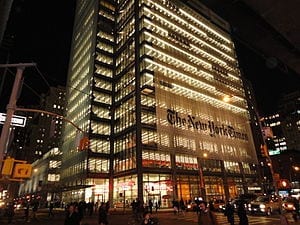Using the sun to light office buildings instead of electricity saves energy. But is it affordable?
The radiometer tracks the sun’s progress across the Manhattan skyline and sends a signal from the roof to the command computer on a floor 90 meters below. Blinds fall slowly with the buzz of an electric motor, cutting off the sun’s glare on computer screens. Another computer triggers the shades on the opposite side of the building to rise while another system shuts off the air-conditioning and adjusts the internal lights.
The New York Times Co. saves energy at its 52-story headquarters using the oldest lighting technology in the world: the sun. Floor-to-ceiling windows let sunlight flood into the office space and sensors then dim the internal lights to save energy. In the process, compared with other buildings in New York City, the Times Building has reduced its energy use by 24 percent, according to a new report prepared by Lawrence Berkeley National Laboratory (LBNL).
Letting the sun do the work of lighting up buildings is obvious. It’s cheap, it’s free and it’s as easy as a window. Or, as managing director of Sustainable Energy Partnerships Adam Hinge says, “there are lessons we can relearn” from the building practices of the time before cheap fossil fuels and ubiquitous air-conditioning. As it stands, the energy used to light, cool and vent the buildings of the world’s cities accounts for roughly 40 percent of humanity’s carbon dioxide emissions, the greenhouse gas primarily responsible for climate change.
But using daylight turns out to be more complicated than building floor-to-ceiling windows. A modern building in a city like New York requires specific glazing on its windows to control glare as well as some form of shade to block at least some of the sunlight and enable employees to see their computer screens. An energy-efficient system requires dimmable lights that must be affordable, long-lasting and easy to maintain. And the people using the building must like the system—or at least find it easy to control.
In a bid to gain a better understanding of all those factors, the Times built a full-scale model of 400 square meters of the building in College Point, Queens, to test various systems before going ahead with final construction in Manhattan. Even then, outfitting the Times’s 20 floors of office space with daylighting equipment constituted “the largest direct procurement of innovative lighting and shading technologies in the U.S.,” according to the LBNL report.
New York City boasts some 10 percent of all the office space in the entire U.S.—more than 50.1 million square meters—and could save $70 million a year in power costs, or roughly 340 gigawatt-hours of electricity, by relying more on sunshine (as well as even simpler fixes like turning off the lights that are not needed at night.) That’s according to another recently released report dubbed “Let There Be Daylight” from Green Light New York, an advocacy group, which notes that more than a quarter of the energy used in New York City’s buildings goes to interior lighting, which is often used even in the middle of a sunny day.
via Scientific American – David Biello
The Latest Streaming News: Can Sunshine Light Skyscrapers updated minute-by-minute
Bookmark this page and come back often
Latest NEWS
Latest VIDEO








